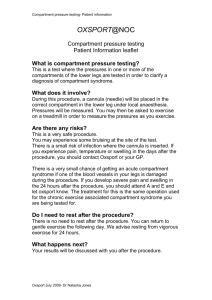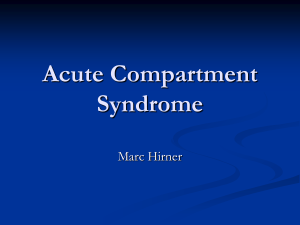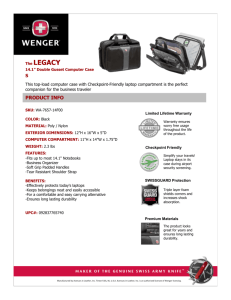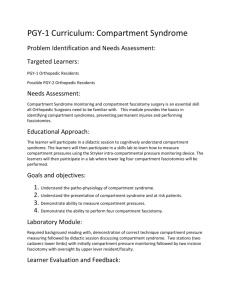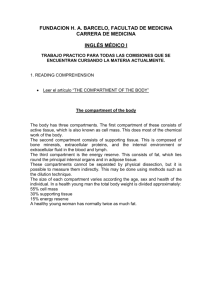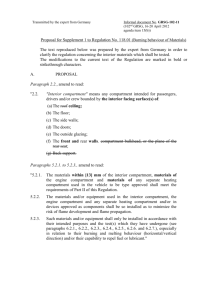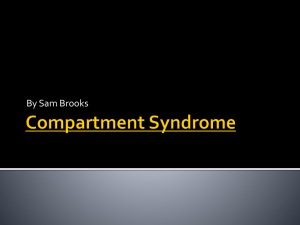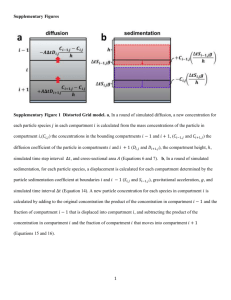Compartment Syndromes
advertisement
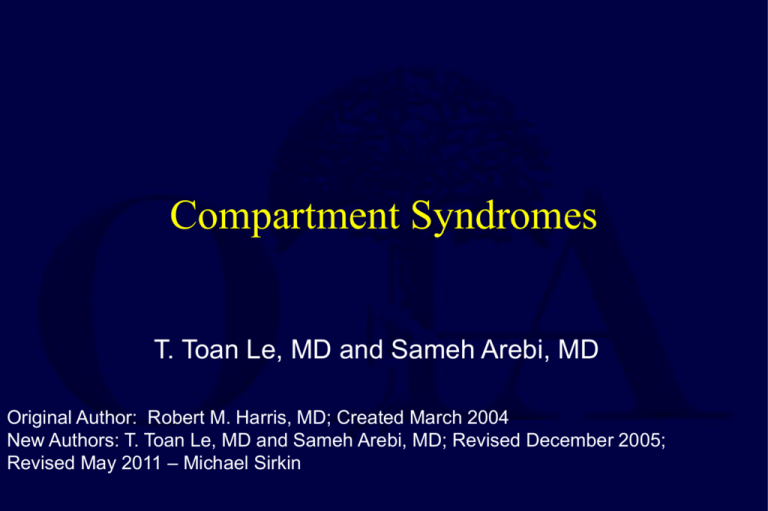
Compartment Syndromes T. Toan Le, MD and Sameh Arebi, MD Original Author: Robert M. Harris, MD; Created March 2004 New Authors: T. Toan Le, MD and Sameh Arebi, MD; Revised December 2005; Revised May 2011 – Michael Sirkin Today • • • • What is it Pathophysiology Diagnosis Treatment Increase in hydrostatic pressure in closed osteofascial space resulting in decreased perfusion of muscle and nerves within compartment • RAISED PRESSURE WITHIN A CLOSED SPACE with a potential to cause irreversible damage to the contents of the closed space Richard Von Volkmann, 1881 • “For many years I have noted on occasion, following the use of bandages too tightly applied, the occurrence of paralysis and contraction of the limb, NOT … due to the paralysis of the nerve by pressure, but as a quick and massive disintegration of the contractile substance and the effect of the ensuing reaction and degeneration.” Definition • Symptoms resulting from increased pressure within a limited space – compromising • circulation • function Pathophysiology • Local Blood Flow is reduced as a consequence: LBF=Pa-Pv / R (A-V Gradient) Pathophysiology • A continuous increase in pressure within a compartment occurs until the low intramuscular arteriolar pressure is exceeded and blood cannot enter the capillaries Pathophysiology • Increased compartment pressure Increased venous pressure Decreased blood flow Decreases perfusion Pathophysiology • Autoregulatory mechanisms may compensate: – Decrease in peripheral vascular resistance – Increased extraction of oxygen • As system becomes overwhelmed: – Critical closing pressure is reached – Oxygen perfusion of muscles and nerves decreases Muscle Ischemia • 4 hours - reversible damage • 8 hours - irreversible changes • 4-8 hours - variable Hargens JBJS 1981 Muscle Ischemia • Myoglobinuria after 4 hours – Renal failure – Maintain a high urinary output – Alkalinize the urine • Cell death initiates a “vicious cycle” – increase capillary permeability – increased muscle swelling Increased muscle swelling Increased permeability Increased compartment pressure • Increased pressure Increased venous pressure Decreased blood flow Decreases perfusion Repetitive Cycle Increased muscle swelling Increased permeability Increased compartment pressure Nerve Ischemia • 1 hour - normal conduction • 1- 4 hours - neuropraxic damage reversible • 8 hours - axonotmesis and irreversible change Hargens et al. JBJS 1979 Pathophysiology: • CAUSES: • Increased Volume - internal : hemmorhage, fractures, swelling from traumatized tissue, increased fluid secondary to burns, postischemic swelling • Decreased volume - external: tight casts, dressings • Most common cause of hemmorhage into a compartment: fractures of the tibia, elbow, forearm or femur Etiology • Fractures • Soft Tissue Injury (Crush) • Arterial Injury – Post-ischemic swelling – Reperfusion injury • Drug Overdose (limb compression) • Burns Pathophysiology: Most common cause of compartment syndrome is muscle injury that leads to edema Arterial Injuries • Secondary to revascularization: • Ischemia causes damage to cellular basement membrane that results in edema • With reestablishment of flow, fluid leaks into the compartment increasing the pressure Diagnosis • Clinical diagnosis – High index of suspicion • Syndrome – History – Physical Exam Difficult Diagnosis • Classic signs of the 5 P’s - ARE NOT RELIABLE: – – – – – pain pallor paralysis pulselessness paresthesias • These are signs of an ESTABLISHED compartment syndrome where ischemic injury has already taken place • These signs may be present in the absence of compartment syndrome. Diagnosis • Pain • Compartment pressure – Confirmatory test – Don’t just measure Diagnosis • Palpable pulses are usually present in acute compartment syndromes unless an arterial injury occurs • Sensory changes and paralysis do not occur until ischemia has been present for about 1 hour or more Diagnosis • The most important symptom of an impending compartment syndrome is PAIN DISPROPORTIONATE TO THAT EXPECTED FOR THE INJURY Signs & Symptoms • Pain –Passive muscle stretching –Out of proportion –Progressive –Not relieved by immobilization Signs & Symptoms • Pain –May be worse with elevation –Patient will not initiate motion on own • Be careful with coexisting nerve injury Signs & Symptoms • Parasthesia –Secondary to nerve ischemia • Must be differentiated from nerve injury Signs & Symptoms • Paralysis (Weakness) – Ischemic muscles lose function Signs & Symptoms • Tense compartment on palpation • Elevated compartment pressure Tissue Pressure • Normal tissue pressure – 0-4 mm Hg – 8-10 with exertion • Absolute pressure theory – 30 mm Hg - Mubarak – 45 mm Hg - Matsen • Pressure gradient theory – < 20 mm Hg of diastolic pressure – Whitesides – < 30 mm Hg of diastolic pressure McQueen, et al Tissue-Pressure: Principles • Originally, fasciotomies for tissue-pressures greater-than 30mmHg • Whitesides et al in 1975 was the first to suggest that the significance of tissue pressures was in their relation to diastolic blood pressure. • McQueen et al: absolute compartment pressure is an UNRELIABLE indication for the need for fasciotomies. BUT, pressures within 30mmHg of DP indicate compartment syndrome Tissue-Pressure: Principles • Heckman et al demonstrated that pressure within a given compartment is not uniform • They found tissue pressures to be highest at the site or within 5cm of the injury • 3 of their 5 patients requiring fasciotomies had sub-critical pressure values 5cm from the site of highest pressure Who is at high risk? High energy fractures • Severe comminution • Joint extension • Segmental injuries • Widely displaced • Bilateral • Floating knee • Open fractures Impaired Sensorium • Alcohol • Drug • Decreased GCS • Unconscious • Chemically unconscious • Neurologic deficit • Cognitively challenged Diagnosis • The presence of an open fracture does NOT rule out the presence of a compartment syndrome • 6-9% of open tibial fractures are associated with compartment syndromes • McQueen et al found no significant differences in compartment pressures between open and closed tibial fractures • No significant difference in pressures between tibial fractures treated with IM Nails and those treated with Ex-Fix Criteria-Compartment Pressure • Accurately examine – Difference < 30mm Hg • Impaired – Absolute > than 30mm Hg Needle Infusion Technique-Historical • Needle inserted into muscle, tube with air/saline interval kept at this height, manometer indicates pressure • Air injected by syringe via 3-way stopcock • When the pressure of the injected air exceeds the compartment pressure pressure, the saline interval moves in the tube • AT this point, the second person reads the pressure from the manometer NEED 2 PEOPLE ! saline Pressure Measurement • Infusion – manometer – saline – 3-way stopcock (Whitesides, CORR 1975) • Catheter – wick – slit catheter • Arterial line – 16 - 18 ga. Needle (5-19 mm Hg higher) – transducer – monitor • Stryker device – Side port needle Pressure Measurement • Needle – 18 gauge – Side ported • Catheter – wick – slit • Performed within 5 cm of the injury if possible-Whitesides, Heckman Side port • • • • • Unit and needle set Assemble unit and prime Hold at angle to measure Zero machine Test each of 4 compartments – Keep calf off of bed Most Common Locations • Leg: deep posterior and the anterior compartments • Forearm: volar compartment, especially in the deep flexor area Where to Measure Pressure • Deeper muscles are initially involved • Distance from fracture affects pressure Heckmen et al. JBJS 1994 Compartments • Anterior • Lateral • Posterior –Deep –Superficial Compartments • Anterior • Lateral • Posterior –Deep –Superficial TA EDL EHL Peroneus TP FHL Soleus Gastroc FDL Treatment • Remove restricting bandages • Serial exams • When diagnosis made – Immediate surgery • 4 compartment fasciotomy Treatment THE ONLY EFFECTIVE WAY TO DECOMPRESS AN ACUTE COMPARTMENT SYNDROME IS BY SURGICAL FASCIOTOMY!!! (unless missed compartment syndrome) Treatment • Fasciotomy –One incision • With or without Fibulectomy –Two incisions • All 4 compartments must be released –Not selective One Incision • Direct lateral incision Perifibular Fasciotomy • One incision • Head of fibula to proximal tip of lateral malleolus • Incise fascia between soleus and FHL distally and extended proximally to origin of soleus from fibula • Deep posterior compartment released off of the interosseous membrane, approached from the interval between the lateral and superfical posterior compartments • Lateral compartment • Anterior compartment Alternative Through intermuscular septum to reach superficial posterior compartment Two incisions • Lateral • Medial Double Incision • 2 vertical incisions separated by a skin bridge of at least 8 cm • Anterolateral Incision: from knee to ankle, centered over interval between anterior and lateral compartments Double Incision • Posteromedial Incision: centered 1-2cm behind posteromedial border of tibia • Soleus must be detached from tibia in order to adequately decompress proximal portion of deep posterior compartment Thigh • Rare • Crush injury with femur fracture • Over distraction – relative under distraction Thigh • Quadriceps –Lateral • Hamstrings –Posterior • Abductor –Medial Treatment • Based upon involvement • Usually Quadriceps and Hamstrings • Usually, a single lateral incision will suffice Compartments of the Forearm • Forearm can be divided into 3 compartments: Dorsal, Volar and “Mobile Wad” • Mobile Wad: Brachioradialis, ECRL, ECRB • Dorsal: EPB, EPL, ECU, EDC • Volar: FPL, FCR, FCU, FDS, FDP, PQ Henry Approach • Incision begins proximal to antecubital fossa and extends across carpal tunnel • Begins lateral to biceps tendon, crosses elbow crease and extends radially, then it is extended distally along medial aspect of brachioradialis and extends across the palm along the thenar crease • Alternatively, a straight incision from lateral biceps to radial styloid can be used. Henry Approach • Fascia over superficial muscles is incised • Care of NV structures Henry Approach • Brachioradialis and superficial radial n. are retracted radially and FCR and radial artery are retracted ulnar to expose the deep volar muscles • Fascia of each of the deep muscles is then incised Post Fasciotomy… • Must get bone stability – IMN – exfix • ~48hrs after procedure patient should be brought back to OR for further debridement • Delayed skin closure or skin-grafting 3-7 days after the fasciotomies Aftercare • • • • Xeroform VAC dressings Elevation of limb Delayed wound closure – Split thickness skin graft Remember… • Fasciotomies are not benign • Complications are real >25% – – – – – Chronic swelling Chronic pain Muscle weakness Iatrogenic NV injury Cosmetic concerns *** BUT if they are needed do not come up with excuses to not do them !!! Chronic (Exertional) Compartment Syndrome • Transient rise in compartmental pressure following activity • Symptoms –Pain –Weakness –Neurologic deficits Chronic Compartment Syndrome • Stress Test –Serial Compartment Pressure • Resting >15mm Hg • 5 min post-ex. >25mm Hg » Rydholm et al CORR 1983 –Volumetrics –Nerve conduction Velocities » Pedowitz et al. JHS 1988 Chronic Compartment Syndrome • Treatment – Modification of activity – Splinting – Elective Fasciotomy Conclusion • • • • Very important to make diagnosis Missed compartment is devastating Physical exam Re-examine patient! If you would like to volunteer as an author for the Resident Slide Project or recommend updates to any of the following slides, please send an e-mail to ota@ota.org Return to General/Principles Index
